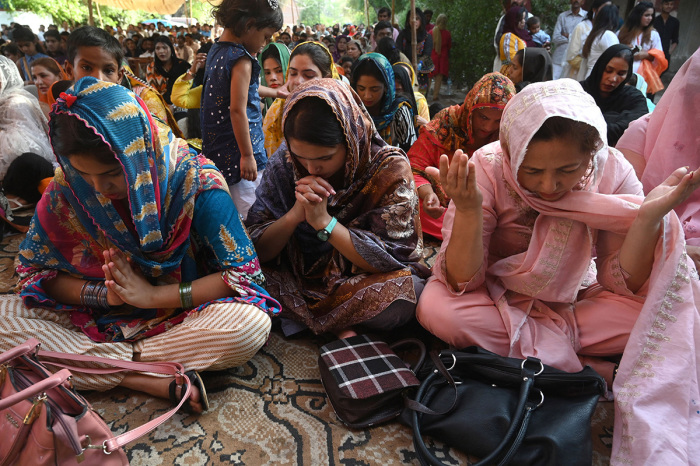Protest erupts as bill protecting underage girls from forced marriage passes in Pakistan province – Christian Post

Report on the Balochistan Child Marriages Restraint Act 2025 and its Alignment with Sustainable Development Goals
Introduction: Legislative Progress on Gender Equality and Child Protection
The provincial assembly of Balochistan, Pakistan, has passed the Child Marriage Prohibition Bill, officially titled the Balochistan Child Marriages Restraint Act 2025. This legislation marks a significant advancement in aligning the province’s legal framework with international human rights standards and the United Nations Sustainable Development Goals (SDGs), particularly those concerning gender equality, justice, health, and education.
- SDG 5 (Gender Equality): The Act directly addresses Target 5.3, which calls for the elimination of all harmful practices, such as child, early, and forced marriage.
- SDG 16 (Peace, Justice and Strong Institutions): By establishing a robust legal framework to protect children, the law contributes to Target 16.2, which aims to end abuse, exploitation, trafficking, and all forms of violence against children.
Key Provisions of the Act and SDG Contributions
Legislative Framework
The Act introduces comprehensive measures to eradicate child marriage, replacing the colonial-era Child Marriage Restraint Act of 1929. Its core provisions are designed to create a strong deterrent and protective shield for children.
- Uniform Age of Marriage: Establishes 18 years as the legal minimum age for marriage for all individuals, a critical step for ensuring both boys and girls can complete their education, aligning with SDG 4 (Quality Education).
- Strict Penalties: Imposes severe sanctions, including imprisonment of two to three years and fines up to 200,000 Pakistani rupees ($707 USD), for any adult male contracting a child marriage or any individual facilitating one.
- Accountability of Officials: Mandates that marriage solemnizers (Nikah Khawans) and registrars verify the national identity cards of both parties to confirm they are of legal age. Failure to comply is a criminal offense.
- Legal Status of Offenses: All offenses under the Act are classified as cognizable, non-bailable, and non-compoundable, strengthening the justice system’s capacity to prosecute offenders effectively, in line with SDG 16.
- Protection for Victims: Declares child marriages void if the minor was kidnapped, sold, compelled, or trafficked. It also ensures that any children born from such unions are considered legitimate, with the father responsible for their maintenance, supporting SDG 3 (Good Health and Well-being).
Stakeholder Responses and Broader Implications
Support from Governmental and International Bodies
The legislation has received widespread commendation from human rights advocates and international organizations for its potential to transform the lives of children in the province.
- UNICEF: Lauded the bill as a milestone that safeguards children’s rights and helps build safer, healthier futures, directly reflecting the ambitions of multiple SDGs.
- Provincial Government: Balochistan’s Chief Minister, Sarfraz Bugti, defended the law as a product of a democratic process enacted in the public’s best interest.
- Civil Society: Activists and lawmakers are urging the provinces of Punjab and Khyber Pakhtunkhwa to adopt similar legislation to ensure nationwide protection for children.
Political Opposition and Challenges
The bill’s passage was met with strong opposition from some political factions, who argued it was contrary to Islamic teachings. Opposition members protested and have stated their intention to challenge the law in court. This highlights ongoing challenges in implementing progressive legislation that aligns with global development goals.
National Context and Contribution to SDG 10 (Reduced Inequalities)
Protecting Vulnerable and Minority Communities
The new law is particularly significant for its potential to protect underage girls from minority communities, who are often targets of forced conversion and marriage. This directly supports SDG 10 (Reduced Inequalities) by providing legal recourse against practices that disproportionately affect vulnerable populations.
- Christian lawmakers have expressed hope that this legislation will pave the way for a similar bill in Punjab, which is critical to protecting minor Christian girls from abduction and forced marriage under the guise of religious conversion.
- The issue of forced marriage is a significant barrier to achieving equality, as it often involves kidnapping, rape, and coercion, which this law seeks to criminalize definitively.
Conclusion: A Legislative Step Towards a Sustainable Future
The Balochistan Child Marriages Restraint Act 2025 represents a crucial step forward for Pakistan in its commitment to the Sustainable Development Goals. By legally prohibiting child marriage, the province is not only protecting the fundamental rights of children but also laying the groundwork for improved outcomes in health (SDG 3), education (SDG 4), gender equality (SDG 5), and justice (SDG 16). The successful implementation and nationwide adoption of such laws will be vital for fostering a more equitable and sustainable society.
Analysis of the Article in Relation to Sustainable Development Goals
-
SDGs Addressed or Connected to the Issues Highlighted in the Article
The article on the passage of the Child Marriage Prohibition Bill in Balochistan, Pakistan, directly addresses and connects to several Sustainable Development Goals (SDGs). The primary goals are:
- SDG 5: Gender Equality: The article’s central theme is the protection of “children, especially girls, from forced child marriages.” This directly aligns with SDG 5, which aims to achieve gender equality and empower all women and girls. The law is a significant step towards eliminating a practice that disproportionately affects girls.
- SDG 16: Peace, Justice and Strong Institutions: The article details the creation of a new legal framework, “The Balochistan Child Marriages Restraint Act 2025,” which establishes legal procedures, penalties, and enforcement mechanisms. It describes the law-making process in the provincial assembly, the repeal of the colonial-era “Child Marriage Restraint Act of 1929,” and the specific roles of the police and judiciary. This directly relates to building effective, accountable, and inclusive institutions and promoting the rule of law.
Additionally, the issues discussed are indirectly connected to the following SDGs:
- SDG 3: Good Health and Well-being: By aiming to prevent child marriage, the legislation contributes to protecting the physical and mental health of children. The UNICEF statement quoted in the article supports this by mentioning the goal of building “safer, healthier, and more hopeful futures.”
- SDG 4: Quality Education: Child marriage is a major barrier to education, particularly for girls. Preventing it allows children to continue their schooling, which is a prerequisite for achieving quality education for all. UNICEF’s mention of safeguarding “childhoods” implies the protection of a child’s right to education.
- SDG 10: Reduced Inequalities: The article highlights the particular vulnerability of “minor Christian girls” who are subjected to forced conversion and marriage. The law aims to protect all children under 18, thereby addressing inequalities based on age, gender, and religion.
-
Specific Targets Identified Based on the Article’s Content
Based on the article, the following specific SDG targets can be identified:
- Target 5.3: Eliminate all harmful practices, such as child, early and forced marriage and female genital mutilation. The entire article is focused on the new law that “sets 18 as the legal age for marriage in Balochistan Province” and introduces “severe penalties for those involved in child marriages.” This is a direct legislative action to eliminate the harmful practice of child marriage.
- Target 16.2: End abuse, exploitation, trafficking and all forms of violence against and torture of children. The article explicitly states that the law declares child marriages void if the minor is “kidnapped, sold, enticed, compelled or trafficked for marriage or immoral purposes.” It also describes how young girls are “abducted, forced to convert to Islam and raped under cover of Islamic ‘marriages’,” which are forms of abuse, exploitation, and violence that the law seeks to end.
- Target 16.3: Promote the rule of law at the national and subnational levels and ensure equal access to justice for all. The passage of the “Balochistan Child Marriages Restraint Act 2025” is a clear example of promoting the rule of law at the subnational level. The article details specific legal provisions, such as offenses being “cognizable, non-bailable, and non-compoundable,” and specifies that “Only a First Class Judicial Magistrate can try offenses,” which are measures to strengthen the justice system.
-
Indicators Mentioned or Implied in the Article
The article implies several indicators that can be used to measure progress towards the identified targets, even if it does not provide specific data:
- Legal Framework as an Indicator: The primary indicator mentioned is the successful passage and enactment of the “Balochistan Child Marriages Restraint Act 2025.” This act itself, which sets the legal age of marriage to 18, serves as a key indicator of progress towards Target 5.3.
- Enforcement and Prosecution Data: The article details penalties for offenders, including “two- to three-years imprisonment and a fine.” An implied indicator of the law’s effectiveness would be the number of arrests, prosecutions, and convictions of individuals who contract or facilitate child marriages under this new act. This would measure progress towards Target 16.2.
- Verification and Registration Compliance: The law requires Nikah Registrars and other officials to “verify the Computerized National Identity Cards (CNICs) of both parties before solemnizing a marriage.” The rate of compliance with this verification process is a measurable indicator of the implementation of the rule of law (Target 16.3).
- Prevalence of Child Marriage: Although not stated with figures, the ultimate indicator for Target 5.3 is a reduction in the prevalence of child marriage in Balochistan. The law’s success would be measured by a decrease in the proportion of girls under 18 who are married.
-
Table of SDGs, Targets, and Indicators
SDGs Targets Indicators Identified in the Article SDG 5: Gender Equality Target 5.3: Eliminate all harmful practices, such as child, early and forced marriage. - The establishment of 18 as the legal minimum age for marriage through the “Balochistan Child Marriages Restraint Act 2025.”
- Reduction in the prevalence of marriage for girls under the age of 18.
SDG 16: Peace, Justice and Strong Institutions Target 16.2: End abuse, exploitation, trafficking and all forms of violence against children. - Number of prosecutions and convictions for crimes related to child marriage, including kidnapping, trafficking, and forced marriage.
- Implementation of penalties (imprisonment and fines) for offenders as stipulated in the act.
SDG 16: Peace, Justice and Strong Institutions Target 16.3: Promote the rule of law at the national and subnational levels and ensure equal access to justice for all. - The formal repeal of the “Child Marriage Restraint Act of 1929” and its replacement with the new 2025 Act.
- Rate of compliance with the mandatory verification of Computerized National Identity Cards (CNICs) before marriage registration.
- Number of cases tried by a First Class Judicial Magistrate under the new law.
Source: christianpost.com
What is Your Reaction?
 Like
0
Like
0
 Dislike
0
Dislike
0
 Love
0
Love
0
 Funny
0
Funny
0
 Angry
0
Angry
0
 Sad
0
Sad
0
 Wow
0
Wow
0
















































:focal(1500,1000)/https://media.globalcitizen.org/a6/9a/a69a4720-d8a1-4715-b596-18738d03c05c/rotary_polio_hero_image.jpg?#)







/countries/sri-lanka/photo-credit---dmc-sri-lanka.tmb-1200v.jpg?sfvrsn=dc298bcc_1#)

















